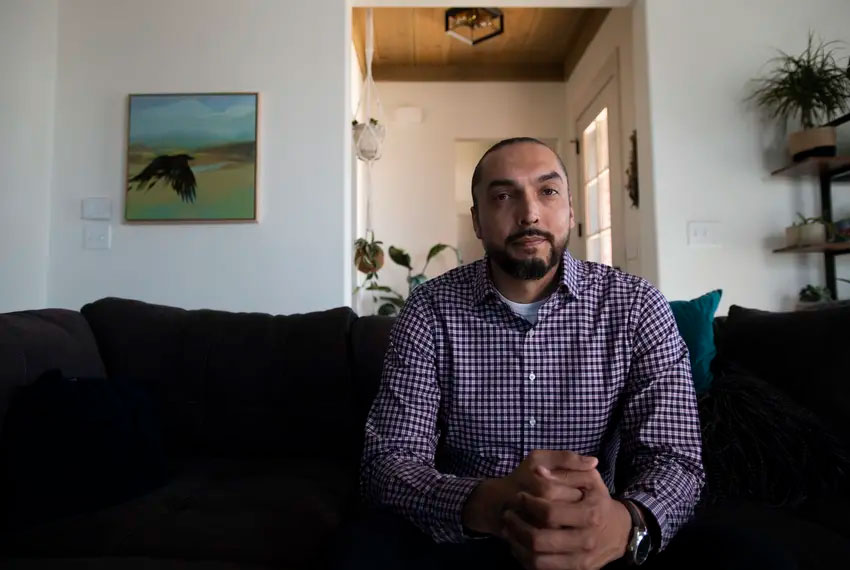According to a new analysis by a national health care company, Lubbock has the highest rate of attempted suicides by children between the ages of 6 and 17. A local leader suggests a dearth of resources isn’t helping.
Adam Hernandez was volunteering at a local middle school in mid-January when a student he mentors asked about his daughter, Jacquelyn.
Jacquelyn was three weeks shy of her 18th birthday when she died by suicide in 2018. She left no note, and the unrelenting question was, “Why?” There were exciting moments on her horizon — she had just graduated from high school and wanted to be an EMT, and her sister’s birthday was coming up.
“We can never know what she was feeling or going through,” Hernandez said.
At her funeral, Jacquelyn’s friends spoke lovingly of her, of simple, everyday interactions. It made Hernandez question if, in her darkest moment, she knew how important she was.
Hernandez has had many other questions since her death: Could he have done anything to help his oldest daughter see the light in the tunnel? What could he do to prevent another person from killing themself?
“It seemed out of nowhere,” Hernandez said. “So I try to tell people that even if you think everything is OK, you need to check in with your kids and try to be there for them as much as you can, because you can never really tell.”
He talked to his student about her that day. He talks to anyone who asks. It’s worth reopening the wound if he can convince one person to think twice before taking their life.
Hernandez’s efforts could go a long way in Lubbock, as it increasingly seems that the city’s children and teenagers are not OK. An independent analysis of national insurance claims by Nomi Health shows that in Texas, Lubbock has the highest rate of youth suicide attempts for children between 6-17 years old, followed by San Antonio and Dallas.
“We have to understand that this is a time of transition for adolescents,” said Sara Ratner, president of government programs for Nomi Health, a national health care company. “When they’re put under a lot of stress, it can spike these thoughts of self-harm and suicide.”
Suicide is the second leading cause of death for people between 15-34 years old in Texas, according to the Department of Health and Human Services. Treatment is increasingly hard to find and afford across the state, which has created a problem as the state continues to grow.
“Despite Texas being the fastest-growing state, which loves to be trumpeted by our state leaders, our state continually ranks among the bottom 10 as it relates to access to mental health resources,” said Cameron Brown, assistant professor of couple, marriage and family therapy at Texas Tech University.
Some bills filed in this year’s legislative session aim to address that gap in schools, where it may be needed most. But in order to bring change for Texans, Brown said mental health must be a priority.
“As our population continues to increase, which is a really great thing, we also need to ensure that we’re investing in resources to support that community,” Brown said.
“There’s not always signs”
The last day Hernandez spent with his daughter Jacquelyn seemed to be a normal Saturday afternoon. It was the kind of day their family was used to having, filled with jokes, laughter and Jacquelyn’s bright smile.
As far as Hernandez could tell, she was happy. They all were.
“There’s not always signs,” Hernandez explained. “With some kids, you can tell they’re depressed or getting bullied, but that wasn’t the case with my daughter. She was super happy.”
Through a retrospective lens that can only come with grief, he can see how Jacquelyn put her plan into motion. Things that seemed ordinary, such as going home without her sister, now carry a different weight. She knew she would be alone, her thoughts and actions uninterrupted.
The next afternoon, everything changed.
“I think deep down, she knew she could talk to me, but you just never know in those moments,” Hernandez said. “I try to tell kids now that it’s important to say something to somebody, even if they don’t want to have those conversations with their mom or dad.”
Kids seem extremely reluctant to talk to their parents, or anyone, about their problems. Data from the National Alliance on Mental Illness shows nearly 65% of Texans between 12-17 years old who have depression did not receive any care in 2021.
And in the High Plains regions of Texas that includes Lubbock and 40 nearby counties, if kids do feel depressed, there are two hurdles that can be hard to overcome. One is the heavy stigma that comes with mental health in the area — conversations about troubling thoughts are met more with hushed whispers than open arms, and it’s an attitude that has continued through generations.
In the past, Brown recalls being denied office space because the owner had a negative view of people seeking therapy.
“If I’m experiencing it as a mental health professional with boots on the ground, then stigma is alive and well within households, classrooms and various communities,” Brown said, adding that the stigma is inflamed when community leaders don’t talk about mental health.
If they can overcome the stigma, they then have to find help, which isn’t an easy task where the people needing treatment outnumber the professionals to take care of them. According to the latest federal data, in 2015, Lubbock County had 3.1 psychiatrists for every 10,000 kids under 18. At the same time, there were 6.4 psychiatrists for every 10,000 children in Travis County.
“Mental health facilities and resources are grossly underdeveloped here,” said Brown, who also practices at Desert Sky Family Therapy.
While it’s hard to say exactly why Lubbock kids have the highest rate of suicide attempts, according to the Nomi Health analysis, Brown speculates the high rate of child abuse might be part of it — Lubbock has had the second highest rate in the state for two years. Brown said that factor, paired with heavy stigma and the minimization of mental health issues, can create a scary environment.
“Even if you are willing to talk about it and make that jump into treatment, it’s going to be hard to get in and get quality treatment,” Brown said.
“All the other good things”
Hernandez and his family are still grieving. Hernandez was in a deep depression for two years after Jacquelyn’s death but tries to talk about her to save another family from tragedy.
“When you join the club of parents that have lost a child, it never goes away,” Hernandez said. “I was so close to my daughter. I was used to seeing her all the time. But she’s just not there anymore.”
The student who asked about Jacquelyn wouldn’t tell Hernandez if they were having suicidal thoughts or if a friend was, he said. Hernandez still talked about his daughter and emphasized that people don’t see how many lives they touch. He wished he would have told the kid a piece of advice that’s kept him going: Focus on the good things in life.
“I still have my other daughter and all the other good things that I have in my life,” Hernandez said. “I really try to focus on that more than feelings of loss and grief.”
There have been local efforts to expand mental health resources in the High Plains. Oceans Behavioral Hospital is opening a new facility in Lubbock that will offer in- and out-patient services for adults and seniors in the region. The Amarillo Area Foundation announced a $475,000 grant last year to include mental health checks in visits with primary care physicians, closing some gaps in the Texas Panhandle.
Locally, Brown hopes to see more investments in mental health care, such as using part of the state’s $32.7 billion budget surplus for teletherapy and physician incentive programs to have them work in rural areas. He wants state leaders to make mental health a priority, but he wants to see that from local leaders too.
“I hope that community leaders, church leaders, school leaders, work administrators, parents, grandparents, all of us, make this a priority,” Brown said.
https://www.texastribune.org/2023/02/16/lubbock-teen-suicide-rates/



